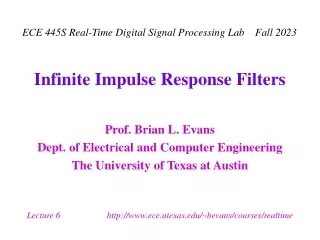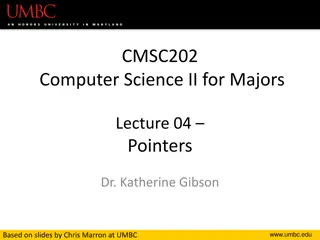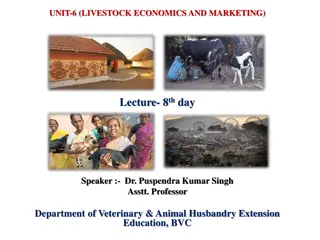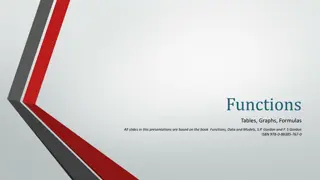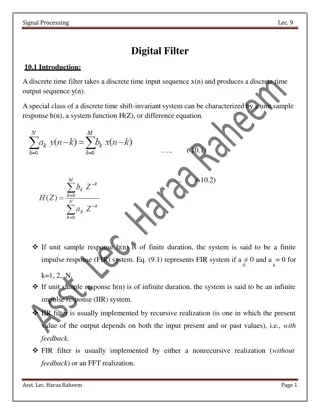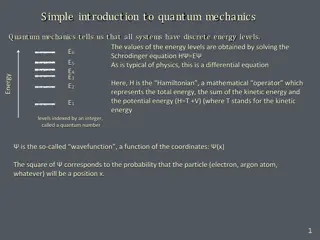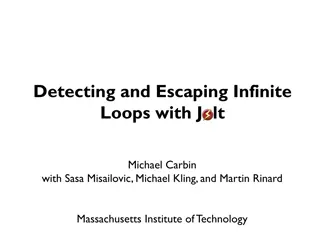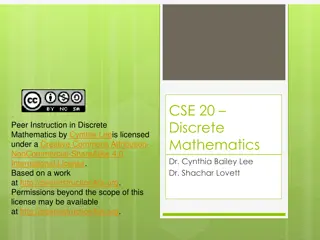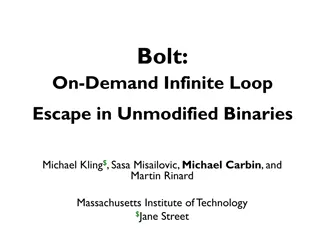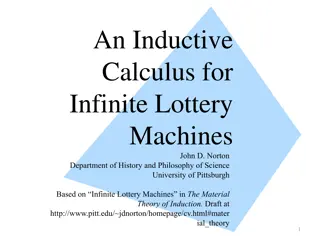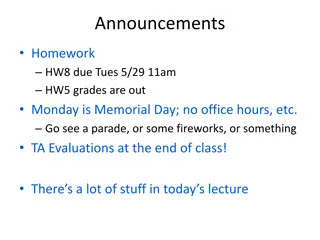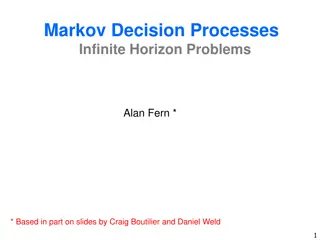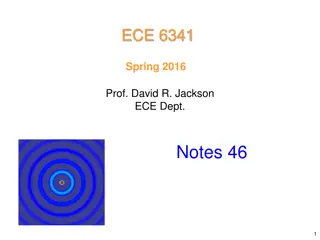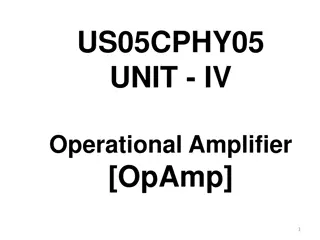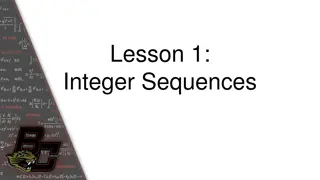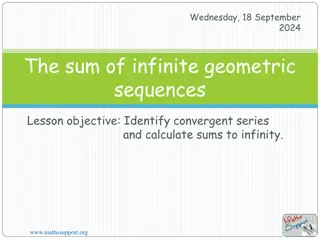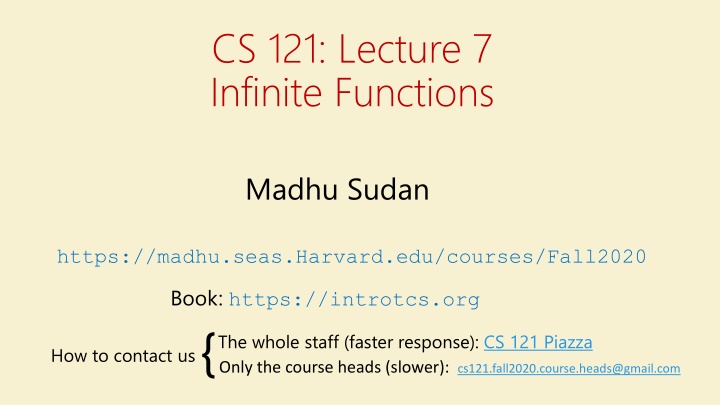
Finite State Algorithms in Computer Science
Explore the concept of finite state algorithms in computer science, covering topics such as deterministic finite automata and regular expressions. Learn about computing finite functions using circuits and the importance of generalization in algorithms.
Download Presentation

Please find below an Image/Link to download the presentation.
The content on the website is provided AS IS for your information and personal use only. It may not be sold, licensed, or shared on other websites without obtaining consent from the author. If you encounter any issues during the download, it is possible that the publisher has removed the file from their server.
You are allowed to download the files provided on this website for personal or commercial use, subject to the condition that they are used lawfully. All files are the property of their respective owners.
The content on the website is provided AS IS for your information and personal use only. It may not be sold, licensed, or shared on other websites without obtaining consent from the author.
E N D
Presentation Transcript
CS 121: Lecture 7 Infinite Functions Madhu Sudan https://madhu.seas.Harvard.edu/courses/Fall2020 Book: https://introtcs.org { The whole staff (faster response): CS 121 Piazza How to contact us Only the course heads (slower): cs121.fall2020.course.heads@gmail.com
Today Infinite vs. Finite functions Example: Addition as finite state algorithm (Deterministic) Finite Automata: Break 1: Understand DFA Break 2: Design DFA Preview of next lecture: Regular Expressions
So far Have seen Circuits/NAND-CIRC Programs Compute all finite functions: Given ?: 0,1? 0,1?, exists NAND-CIRC ?, s.t. ? 0,1?,? ? = ? ? Sounds great?
So far Have seen Circuits/NAND-CIRC Programs Compute all finite functions: Given ?: 0,1? 0,1?, exists NAND-CIRC ?, s.t. ? 0,1?,? ? = ? ? Sounds great? Weakness: Only computes finite functions. No generalization? Given circuits for ADD1,ADD2,ADD3, ADD? - do we know what circuit for ADD?+1 looks like? Our favorite algorithms generalize!!
Today: Algorithms with finite state What should an algorithm be? Sequence of simple steps Different steps for different inputs Exactly which step to take must be determined (based on input, easily, locally). Different #steps for different input lengths When to stop must be determined (based on input, easily, locally). Finite state algorithms: What step to take, when to stop determined by finite state (constant # bits of memory).
Example: Addition as finite state algorithm Advantage: O(1)-sized description. Tells how to compute an infinite function ADD: 0,1 0,1 0,1 Can you do anything else? Multiplication? NO but can do modular counting, pattern matching
Boolean functions From now will focus only on Boolean functions: ?: 0,1 0,1 Why? Given ?: 0,1 0,1 , can design b?: 0,1 0,1 or ??: 0,1 0,1 , that are roughly equally easy/hard . Idea: ?? ?,? = ? ?? If ? ? 0,1? for some ?: Can go from ? ? to ?? ?,? (for any single ?) by erasing other parts of output. Can go from ??(?,?) to ?(?) by ? calls to algorithm for ??( , )
Exercise Break 1 Booleanize ????: 0,1 0,1 0,1 , where ???? is the multiplication function for integers (given in little-endian ). What is domain of your function? What is the range?
Deterministic Finite Automata (DFA) Finite algorithms computing Boolean functions: ?: 0,1 0,1 Operation: 1. Finite number of states: ? 2. Starts in state 0, reads ?0 3. At any stage has current state ?, last read input symbol ? 4. Moves to state ?(?,?); moves to read next input symbol 5. If input not done, repeat from Step 3. 6. When done: Accept (output 1) if current state ? ? and reject (output 0) otherwise. Specification:, ?,? where ?: ? 0,1 [?], ? [?] (more elaborate spec. in Sipser): (?,?0, ,?,?) [ ? = ? ,?0= 0, = {0,1} ]
Example: ? ? = 1 ? contains 011 as a subsequence
Exercise Break 2: 1) Convert the following diagram to transition function: 2) Describe the function ? computed by this DFA.
Regular Expressions Motivation: DFA detects simple patterns in strings. Can it do more complex ones? Regular expressions: A generalization of Patterns . Succinct descriptions of subsets of 0,1 Definition: Basic cases: 0 is a regular expression 1 is a regular expression Compound cases: If ?1,?2 are regular expressions, then so are: ?1?2: ?1 followed by ?2 (or concatenation ) (?1| ?2): ?1or ?2 ?1 : Concatenation of finite number of ?1 s End Cases: ? (empty set) is regular. (null string) is regular.
Examples: 0 1 011 0 1
Regular Expression Matching Basic Compound: ? matches ?1?2 if there exists ?1,?2 such that ? = ?1?2 and ?1 matches ?1 and ?2 matches ?2 ? matches ?1|?2 if ? matches ?1 or ? matches ?2 ? matches ?1 if there exists ?1,?2, ,? such that ? = ?1?2 ? and ?? matches ?1 for every ? 0 matches 0 1 matches 1 matches No string matches ?
Examples: 0 1 1 0 1 1 0|1 1 0 1
Examples: 0 10 10 1
Regular expressions = sets (languages) = functions Can think of a regular expression as a set or as a Boolean function: Given regular expression ? can look at set (language) ? ? = ? 0,1 ? matches ?} ??: 0,1 0,1 where ??? = 1 ? ? ? ? matches ? We prefer the last version
Next two lectures: Understanding DFA via regular expressions: For which regular expressions ? is ? ? computable by a DFA (Note: # states can depend on ?, but not on ? or |?|) What are some functions computable by DFA that are not regular Limits of DFA What are some functions that are not computed by DFA?

